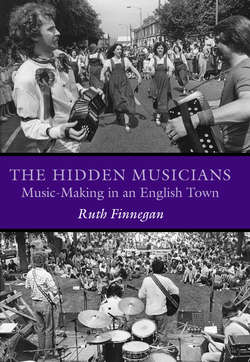Читать книгу The Hidden Musicians - Ruth Finnegan - Страница 10
На сайте Литреса книга снята с продажи.
ОглавлениеAcknowledgments
I have much gratitude to express. Among my more formal thanks – but no less sincere for that – are those to the Faculty of Social Sciences at the Open University for research funding and other support, to the Milton Keynes Development Corporation (MKDC) for a generous grant towards the cost of the illustrations and to the staff of the Open University Library for their unstinting response to my continual requests. I am also most grateful to Eric Gates and the MKDC Recreation Unit for allowing me to consult their files; to Paul Smith (the County Music Adviser) and the Rev. Gethin Abraham-Williams for help and advice on the school and church surveys respectively; and to the many groups and individuals who gave permission for the reproduction of the illustrations or helped me to locate them.
For more personal thanks I must mention first my assistant Liz Close, who did the interviewing that provided much of the quantitative stiffening in this study. Her energy, cheerfulness, and knowledge were invaluable, and I and all readers of this book are greatly indebted to her. I have also been wonderfully fortunate in the cooperation of those at the Open University who over the years helped to organise me and the ever-changing manuscript, particularly Gloria Channing, Joan Smart and Margaret Allot: I could not have done without them.
No study of this kind would be possible without the help of large numbers of local people – musicians and others – who shared their time and insight so freely not only in formal ‘interviews’ but in friendly conversations and tolerant understanding of my own musical inadequacies. I can never fully repay what they gave or write as complete an account as each would deserve, but I hope they will feel that what is written here gives at least some idea of the valued part they play in our musical pathways. Because it is impossible to name all who contributed it seems wrong to single out any; but I cannot refrain from mentioning the particular kindnesses and help given by Matt and Jane Armour, Doreen Beacham, John Close, Malcolm Crane, John and Lila Drinkwater, Rod Hall, Sue Jarvis, Arnold Jones, Clive Keech, Gordon Ratnage, David Stevenson, Anita Tedder, Pauline Thompson, Peter Waterman, Ralph and Cora Willcox, and – let me remember them with particular warmth and gratitude – Ella and Franklin Cheyne. I would also thank my three daughters Rachel, Kathleen and Brigid and their teachers (helpful, if partly unwitting, participants in the research) and – in a very personal tone – Sherwood Choir members for putting up with me over the years, before, during and after this research. To all of these, and to the many others who shared so much with me, my admiration and thanks.
Because this is an unusual study, drawing on many academic areas but not quite orthodox in any of them, I have particularly appreciated friends and colleagues outside the locality who have encouraged me, listened patiently, read part of the typescript, or – maybe without realising it – suggested some new line of thought. Once again they are too many to name, but let me at least acknowledge the great stimulus I received from the participants (critical as well as sympathetic) in the various seminars and workshops where I tried out earlier versions, and, among individuals, from John Blacking, Dieter Christensen, John Davis, Mary Douglas, Jerry Eades, Steven Feld, Simon Frith, Ralph Grillo, Mark Hustwitt, Bernice and David Martin, the McCaugheys of Melbourne, Alan Macfarlane, Jim Obelkvich, Leo Treitler, Elizabeth Whitcombe and Tokumaru Yosihiko (not that any of them will necessarily agree with what I say here). Four friends did their best to delay this too-slowly maturing book by capturing my time for other tasks: Jean La Fontaine, the unstoppable combination of Peter Zorkoczy and Nick Heap, and, most of all, Raymond Illsley; but I find that I am unexpectedly grateful to them too, since the detachment and wider experience they forced on me ultimately helped its completion.
My more general academic debts will probably be obvious from the text of the book. Among them I would particularly pick out the work of Howard Becker, John Blacking, Ulf Hannerz, Richard Bauman and Roger Abrahams. Finally Sue Allen-Mills and her colleagues at Cambridge University Press provided invaluable help, my husband David Murray gave his usual unequalled academic stimulus and moral support, and my mother, as all through my life, started it all off and kept me going.
